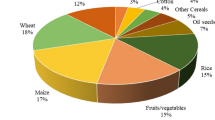Abstract
While the application rate of nitrogen fertilizer is believed to dramatically influence rice fields and improve the soil conditions in paddy fields, fertilization with low use efficiency and nitrogen loss may cause environmental pollution. In this paper, 15N-labeled urea was used to trace the fate of nitrogen at four rates (0, 75, 225 and 375 kg N/ha) of urea fertilizer over three split applications in Hangzhou, Zhejiang, in 2014. Plant biomass, the soil nitrogen content of different layers, NH3 volatilization and N2O emissions were determined using the 15N abundance to calculate the portion from nitrogen fertilizer. The results indicated that rice yields increased with the application rate of nitrogen fertilizer. NH3 volatilization is the main nitrogen loss pathway, and N2O emissions were significantly associated with nitrogen application rates in the paddy. The percent of nitrogen loss by NH3 volatilization and N2O emissions increased with the nitrogen application rate. This study showed that the suitable N fertilizer in a loam clay paddy, considering the yield requirements and environmental issues, is approximately 225 kg N/ha in Hangzhou, with a distribution of 50.06% of the residual in the rice and soil and 48.77% loss as NH3 volatilization and N2O emissions. The nitrate from fertilization mainly remained in the 0–20 cm level of the topsoil.





Similar content being viewed by others
References
Brown KH, Bach EM, Drijber RA et al (2014) A long-term nitrogen fertilizer gradient has little effect on soil organic matter in a high-intensity maize production system. Glob Change Biol 20(4):1339–1350
Cai G, Zhu Z, Trevitt A et al (1986) Nitrogen loss from ammonium bicarbonate and urea fertilizers applied to flooded rice. Fertil Res 10(3):203–215
Climate Change IPCC (2013) The physical science basis. Cambridge University Press, Cambridge
Davidson EA, Belk E, Boone RD (1998) Soil water content and temperature as independent or confounded factors controlling soil respiration in a temperate mixed hardwood forest. Glob Change Biol 4(2):217–227
Deng M, Shi X, Tian Y et al (2012) Optimizing nitrogen fertilizer application for rice production in the Taihu Lake region China. Pedosphere 22(1):48–57
FAO (2013) FAO statistical yearbook 2013 Part 3-feeding the world. Rome
FAO (2015) World fertilizer trends and outlook to 2018. Rome
Gu B, Ju X, Chang J et al (2015) Integrated reactive nitrogen budgets and future trends in China. Proc Natl Acad Sci 112(28):8792–8797
Guo JH, Liu XJ, Zhang Y et al (2010) Significant acidification in major Chinese croplands. Science 327(5968):1008–1010
Kissel DE, Brewer HL, Arkin GF (1977) Design and test of a field sampler for ammonia volatilization. Soil Sci Soc Am J 6(41):1133–1138
Kögel-Knabner I, Amelung W, Cao Z et al (2010) Biogeochemistry of paddy soils. Geoderma 157(1–2):1–14
Malhi SS, Johnston AM, Gill KS et al (2004) Landscape position effects on the recovery of 15N-labelled urea applied to wheat on two soils in Saskatchewan, Canada. Nutr Cycl Agroecosyst 68(1):85–93
Mcswiney CP, Robertson GP (2005) Nonlinear response of N2O flux to incremental fertilizer addition in a continuous maize (Zea Mays L.) cropping system. Glob Change Biol 11(10):1712–1719
Pancras H, Khanif YM (1988) Effect of air-flow rates on laboratory measurement of NH3 volatilization. Pertanika 2(11):323–325
Santoro AE, Buchwald C, Mcilvin MR et al (2011) Isotopic signature of N2O produced by marine ammonia-oxidizing archaea. Science 333(6047):1282–1285
Shan L, He Y, Chen J et al (2015) Ammonia volatilization from a Chinese cabbage field under different nitrogen treatments in the Taihu Lake Basin, China. J Environ Sci 38:14–23
Shcherbak I, Millar N, Robertson GP (2014) Global metaanalysis of the nonlinear response of soil nitrous oxide (N2O) emissions to fertilizer nitrogen. Proc Natl Acad Sci 111(25):9199–9204
Wang DJ (2003) Optimum nitrogen rate for a high productive rice-wheat system and its impact on the groundwater in the Taihu lake area. Acta Pedol Sinica 40(3):426–432
Yang H, Yang JP, Lv YM et al (2014) SPAD values and nitrogen nutrition index for the evaluation of rice nitrogen status. Plant Prod Sci 17(1):81–92
Yao Z, Zheng X, Dong H et al (2012) A 3-year record of N2O and CH4 emissions from a sandy loam paddy during rice seasons as affected by different nitrogen application rates. Agric Ecosyst Environ 152:1–9
Zhang WL, Tian ZX, Zhang N et al (1996) Nitrate pollution of groundwater in northern China. Agric Ecosyst Environ 59(3):223–231
Zhang Q, Yang Z, Zhang H et al (2012) Recovery efficiency and loss of.sup.15N-labelled urea in a rice-soil system in the upper reaches of the Yellow River basin. Agric Ecosyst Environ 158:118
Zhang WF, Dou ZX, He P et al (2013) New technologies reduce greenhouse gas emissions from nitrogenous fertilizer in China. Proc Natl Acad Sci USA 110(21):8375–8380
Zhang X, Yin S, Li Y et al (2014) Comparison of greenhouse gas emissions from rice paddy fields under different nitrogen fertilization loads in Chongming Island, Eastern China. Sci Total Environ 472:381–388
Zhong YM, Wang XP, Yang JP et al (2016) Exploring a suitable nitrogen fertilizer rate to reduce greenhouse gas emissions and ensure rice yields in paddy fields. Sci Total Environ 565:420–426
Zhou S, Sugawara S, Riya S et al (2011) Effect of infiltration rate on nitrogen dynamics in paddy soil after high-load nitrogen application containing 15N tracer. Ecol Eng 37(5):685–692
Zhu ZL, Cai GX, Simpson JR et al (1988) Processes of nitrogen loss from fertilizers applied to flooded rice fields on a calcareous soil in north-central China. Fertil Res 18(2):101–115
Acknowledgements
This study was supported by the National Natural Science Foundation of China (No. 61174089). We thank Mr. Changshui Ge and other professionals from Hangzhou Academy of Agriculture Science for their kind help in the experimental trial and field management.
Author information
Authors and Affiliations
Corresponding author
Rights and permissions
About this article
Cite this article
Zhong, Y., Wang, X., Yang, J. et al. Tracing the fate of nitrogen with 15N isotope considering suitable fertilizer rate related to yield and environment impacts in paddy field. Paddy Water Environ 15, 943–949 (2017). https://doi.org/10.1007/s10333-017-0606-y
Received:
Revised:
Accepted:
Published:
Issue Date:
DOI: https://doi.org/10.1007/s10333-017-0606-y




